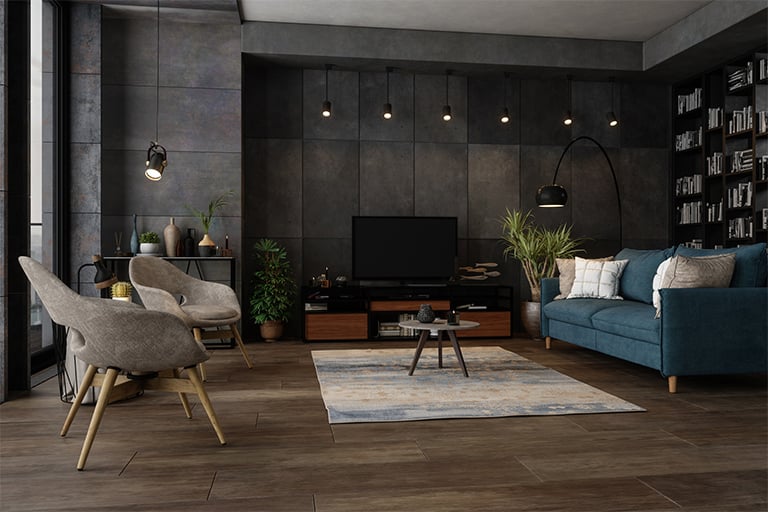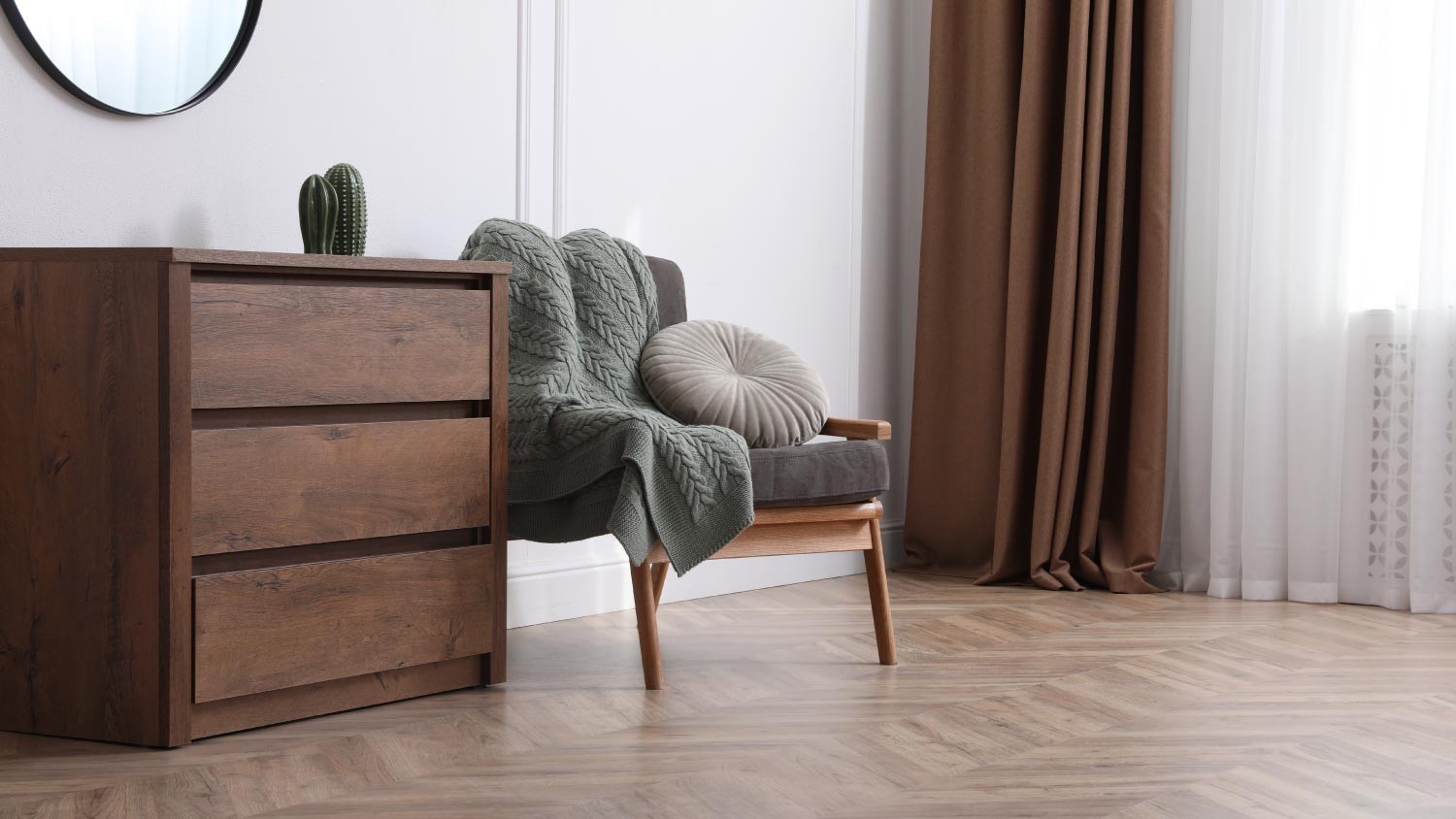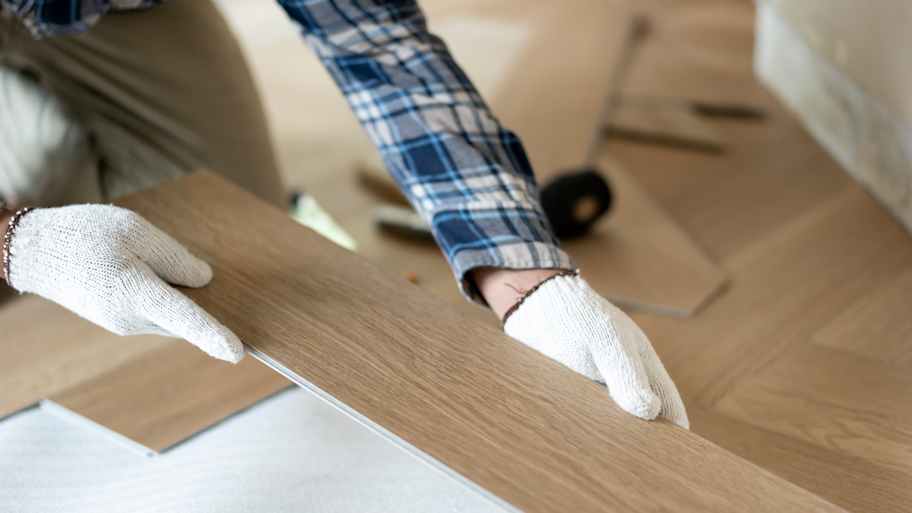
Installing new baseboards can totally refresh the look of your walls. Learn about the cost to install baseboards in your home.
Installing a new floor costs $3,156 on average, but can range between $1,530 and $4,851, depending on the room size and type of flooring.


The size of the area and the type of flooring you choose are the most significant cost factors to consider.
Laminate, vinyl, and linoleum are the most budget-friendly options, and hardwood, stone, and tile are the most expensive.
Budget for subfloor repairs if you’re replacing your flooring due to a plumbing leak or flood.
Consider the water and scratch resistance and overall durability when choosing flooring for longevity and ROI.
For a 500-square-foot space, flooring installation costs between $1,530 and $4,851, for an average of $3,156 (or $12.50 per square foot). However, the overall price to install new floors will depend on multiple factors, including the size of your space, flooring materials, and labor costs in your area.
New flooring costs depend on several different factors. Are you installing flooring in one room or throughout your home? Do you want a less expensive material like vinyl, or are you ready to purchase hardwood flooring? Let’s take a look at the cost factors to consider.
When ordering flooring materials, first measure the square footage of the floor space. You may need to add an extra 10% for wastage during the installation process. A flooring pro can provide guidance for more challenging layouts or stairs.
New flooring costs about $12.50 per square foot, so the larger the project, the more the installation will cost.
| Room Size in Feet | Square Footage | Average Cost |
|---|---|---|
| 10x10 | 100 | $1,250 |
| 10x12 | 120 | $1,500 |
| 12x12 | 144 | $1,800 |
| 12x14 | 168 | $2,100 |
| 14x16 | 224 | $2,800 |
| 16x16 | 256 | $3,200 |
| 18x18 | 324 | $4,050 |
| 18x20 | 360 | $4,500 |
| 20x20 | 400 | $5,000 |
You may get a discount on the rate per square foot for larger projects, while some companies may charge a higher flooring cost per square foot for a small job to meet their minimum project cost requirements.

The price of your new flooring heavily depends on the type of materials you choose. Generally speaking, natural materials are pricier, while synthetic materials are more affordable. For instance, hardwood flooring costs between $6 and $25 per square foot, while linoleum flooring costs $3 to $12 per square foot.
Of course, the type of flooring material that’s best for your home depends on the area you’re putting it in, the amount of traffic it gets, whether you have kids or pets running around, your local weather and climate, and your aesthetic.
As an example, if you’re looking for a stylish and sustainable material, you might consider bamboo flooring (if it’s within your budget). Otherwise, if you’re a budget-conscious pet owner looking for something durable, laminate flooring might be a good option.
| Type of Flooring | Average Cost per Square Foot | Lifespan (years) | Pros | Cons |
|---|---|---|---|---|
| Tile | $15–$20 | 75–100 | Highly durable and waterproof. Easy to clean. | Can chip and crack. Can be difficult to install. |
| Hardwood | $6–$25 | 30–100 | Can be resurfaced and refinished. Lots of variations to choose from. | Susceptible to damage from water and moisture. Requires some maintenance. |
| Engineered Wood | $4.50–$16 | 20–30 | Looks like hardwood and is more resistant to moisture. Can be refinished. | Not entirely moisture resistant. Can only be refinished once or twice. |
| Stone | $6–$20 | 50–100 | Very durable and low maintenance. Sustainable. | May require structural reinforcement due to weight. Difficult installation. |
| Carpeting | $3.50–$11 | 5–15 | Comfortable to walk on. Affordable and easy to install. | Difficult to clean. Stains easily and absorbs odor. |
| Laminate | $3–$13 | 10–30 | Affordable alternative to hardwood. Easy to install. | Not moisture resistant. Difficult to repair, and can’t be refinished. |
| Vinyl | $2–$14 | 10–25 | Affordable and durable. Can mimic other materials like hardwood and stone. | Can become discolored and wear over time. |
| Linoleum | $3–$12 | 20–40 | Recyclable and made from natural materials. Affordable and long-lasting. | Needs to be sealed. Not as durable as other materials. |
| Polished concrete | $2–$16 | 50–75 | Very durable with a long lifespan. Low maintenance and affordable. | May need structural reinforcement due to its weight. Must be properly sealed. |
| Bamboo | $2–$20 | 10–30 | Sustainable and highly durable. | Susceptible to moisture damage. Shorter lifespan than other materials. |
| Cork | $5–$19 | 20–40 | Low maintenance and allergy-friendly. | Not as durable as other flooring. Susceptible to moisture related expansion and contraction. |
Like many home improvement projects, the cost of new flooring and its installation depends on the cost of living in your area.
Finding a flooring contractor near you can be simple, but you’ll want to ask questions, such as if they have worked with the type of flooring you’re using before, whether they’ll handle the prep work and clean-up, and if they offer warranties for their parts and labor.
So, how much does new flooring cost for a 500-square-foot area in your region? Here are some ranges from the East Coast to the West Coast:
| City | Average Cost |
|---|---|
| Trenton, New Jersey | $1,400–$4,000 |
| Boston, Massachusetts | $1,200–$3,250 |
| Miami, Florida | $1,450–$4,400 |
| Atlanta, Georgia | $1,500–$4,400 |
| Chicago, Illinois | $1,600–$4,400 |
| Houston, Texas | $1,700–$5,400 |
| Los Angeles, California | $2,000–$5,700 |
| San Francisco, California | $2,500–$6,800 |
| Seattle, Washington | $1,650–$5,000 |
| St. Paul, Minnesota | $1,200–$3,900 |
The type of flooring you choose will greatly impact the cost of the project, but other factors, like labor, flooring removal, and finishes will also influence the final cost of the project.
Hiring a flooring installer costs about $0.60 to $4 per square foot. Keep in mind that the pro’s hourly rate doesn’t include materials or extra work, like replacing subfloors, removing old flooring, or moving furniture before starting the job.
The flooring installation company may charge an additional rate, around $60 to $120 per hour, to remove furniture from the room or home before installing the floors. Save money on your flooring installation costs by moving furniture and other objects prior to the project’s start date.
Removing old flooring costs $1.50 to $3.50 per square foot, depending on the type of floor and how it was installed. For example, tile removal costs can range from $2 to $7 per square foot, while removing carpet that is nailed or stapled to the floor costs around $1 to $1.50 per square foot.
Subflooring replacement costs $3 to $10 per square foot. Subfloors help support your flooring, whether you choose carpet, tile, or hardwood. You need this base layer to be in good condition, so if your subfloors are too weak or have water damage, you’ll need to repair or replace them before installing new flooring.
If your floor type needs underlayment, it will add $0.50 to $5.40 per square foot to the flooring installation cost. Not all floors need underlayment, but you likely need it if you install carpet or laminate flooring.
Installing flooring on stairs costs $11 to $160 per step, depending on the type of flooring you choose. The cost of adding carpet to stairs falls on the lower end of the scale because it’s easier to install over the curves and ridges of steps than a rigid material like hardwood, which may cost up to $160 per step due to the complexity of installation and higher cost of the material.
Mold remediation costs $10 to $25 per square foot and, if a mold removal pro detects mold, it is a crucial step before laying down new flooring. If a flood or leaky plumbing left mold or water damage under the flooring, you’ll need to factor in the additional costs for a local mold removal service to keep your family safe.
Finishes, like polyurethane, urethane, or wax, cost $0.85 to $7 per square foot. Consider adding a finish to hardwood, natural stone, or concrete flooring to help the material last longer. Finishes are also a good idea for entryways, living rooms, or other high-traffic spaces in your home.
When you’re putting down new floors, you might look around the room and decide to add some other projects at the same time. Here are the average costs for common floor installation add-ons:
Baseboards cost: $800–$2,250
Floor paint costs: $1,000–$2,000
Radiant floor heating costs: $1,700–$6,000
Floor joist replacements cost: $4,000–$12,000
Professional floor cleaning costs: $200–$300
Hardwood floor refinishing costs: $1,100–$2,600

Installing new flooring yourself can seem fairly simple, especially if you’re handy and you have a small, regularly shaped room (think basic square or rectangle). However, flooring materials can be complicated to maneuver, especially if your space isn’t a standard size or shape.
Installing flooring yourself costs from $0.50 to $15 per square foot for materials, not including your prep and labor time. Hiring a local flooring company will run around $3 to $22 per square foot, including labor and materials.
The condition of the floors is a major component of your property’s value. So if the work doesn’t look professional, it can damage your home’s value. Your DIY flooring may need replacing before you sell your property, which will cost you more in the long run. Keep all of these factors in mind before going off on your own.
"Though a DIY flooring installation may be beyond your experience, consider doing the demo or tear-out process yourself,” says Andrew Kilborn, Angi Expert Review Board member and owner of Andy’s Handyman. “Often, it's a great way to save on labor."
An Angi survey found that the most common DIY projects gone wrong include drywall repair, plumbing work, electrical repair, and flooring installation. Mistakes can lead to costly or timely fixes, so if you’re not confident about tackling these projects yourself, consider hiring a pro.
Installing new flooring can add value to your home, but the amount of value it adds will depend on the type of flooring you choose. Hardwood flooring increases home values and has a 75% ROI. Other types of flooring also increase home value, namely ceramic and stone tile, but even installing new carpet or vinyl can give the home an upgrade, potentially increasing its value.
Installing new flooring can have a high upfront investment, but you don’t have to break the bank to get sleek new floors for your home. Here are a few tips for saving on the cost to replace flooring.
You can save money on your flooring installation project by doing some prep work. Removing old carpet or other flooring yourself may save you up to $3.50 per square foot. But you should only remove the existing floors if you can do it without destroying the subfloors if you plan to keep them. Do not attempt to remove the old floors on your own if they are hazardous with mold or asbestos present.
You (and probably a friend or two) can do some of the heavy lifting, literally, to save money on flooring installation costs. Move furniture out of the room and clear the area for new flooring installation rather than paying extra to the flooring installation crew. Keep in mind that moving heavy or bulky furniture is risky, so consider hiring local movers to move furniture within your home.
While you might not want to buy the least expensive floors you can find—that can cause you to have to replace them within a few years—you can save money on flooring installation costs by finding good quality but less expensive materials. Consider more common flooring types rather than rare hardwoods or customized floor panels.
Home is the most important place on earth, which is why Angi has helped more than 150 million homeowners transform their houses into homes they adore. To help homeowners with their next project, Angi provides readers with the most accurate cost data and upholds strict editorial standards. We’ve surveyed over 30,000 real Angi customers about their project costs to develop the pricing data you see, so you can make the best decisions for you and your home. We pair this data with research from reputable sources, including the U.S. Bureau of Labor Statistics, academic journals, market studies, and interviews with industry experts—all to ensure our prices reflect real-world projects.
Want to help us improve our cost data? Send us a recent project quote to [email protected]. Quotes and personal information will not be shared publicly.
From average costs to expert advice, get all the answers you need to get your job done.

Installing new baseboards can totally refresh the look of your walls. Learn about the cost to install baseboards in your home.

How much does marble flooring cost? We’ve got the answers about marble cost per square foot, types of marble, DIY cost, and more.

Discover stamped concrete wall cost estimates, including average prices, key cost factors, and tips to help you budget your project with confidence.

When wondering who to hire to fix squeaky floors, a floor repair professional should give you the best results, starting with diagnosing the problem accurately.

With all the flooring options available on the market today, you may be wondering what exactly is vinyl flooring? Get that answer and more in this guide.

Discover what LVP flooring is, how it performs, where it works best, and why it’s a stylish, low-maintenance choice for busy, spill-prone places.